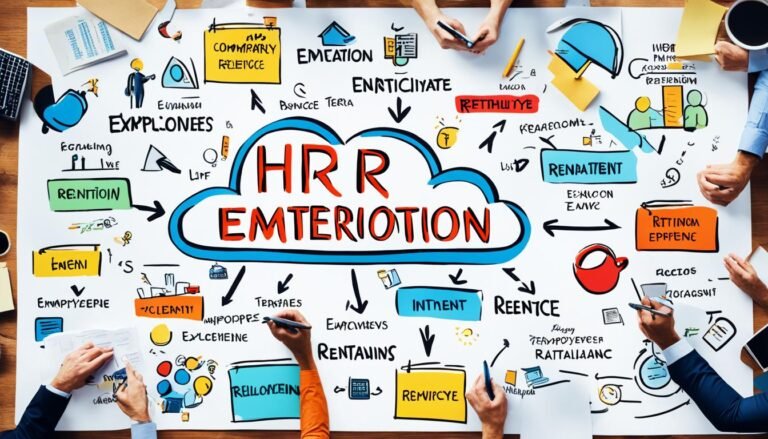How to Fire an Employee Legally?
Most jobs in the U.S. allow employers to fire employees anytime, for any reason. However, legal termination is more than saying, “You’re fired.” Employers need to follow specific steps to avoid legal issues. This includes knowing and acting within the law for both federal and state levels. It’s important to have a clear and fair legal dismissal process. This ensures you fire employees the right way.
To let an employee go legally, certain steps must be followed carefully. First off, check your company’s rules and any employee violations closely. This documentation protects you in case of a lawsuit. It’s also crucial to know laws that protect employees, like those for age and disability. Additionally, each state may have different laws, so be extra careful. For example, Ohio has specific laws for companies with four employees, different from the federal rule of 15.
When deciding to fire someone, make sure your reasons are clear and true. Good communication and solid facts prevent claims of mistreatment. The firing meeting should be quick, private, and polite, lasting about 15 minutes. After firing, meet all legal requirements. This includes COBRA insurance and their final paycheck, to prevent further issues.
Legal advice is wise when dealing with complex firing situations. It helps keep you in line with all laws and reduces risks. Expert advice from people like Sean Peek can make the process smoother and more professional. They ensure you handle things with care and knowledge.
Key Takeaways
- Most U.S. jobs allow firing without giving a reason, but this has to be done within the law.
- Laws prevent firing based on discriminating factors like age or gender.
- It’s essential to document issues and violations well to protect against claims.
- Termination meetings should be handled with care and not last longer than 15 minutes.
- After firing, ensure you meet all legal responsibilities promptly.
- Getting legal advice can guide you through tricky situations and ensure you follow the law.
Understanding At-Will Employment
In the U.S., at-will employment means jobs can end at any time. Both the employer and the employee can decide to stop working, without giving a reason. This is true in all states except Montana, showing how common this rule is.
Definition of At-Will Employment
The At-Will Employment Definition means workers and companies both have the freedom to leave their jobs when they want. But, they must follow laws when they end the work relationship. This ensures that no one’s rights are wrongly taken away or violated.
Exceptions to At-Will Employment
Even with at-will work, some rules protect employees from unfair firing. These include:
1. Public Policy Exception: This lets workers keep their jobs if firing them would break state laws or the state constitution.
2. Implied Contract Exception: In 41 states and Washington, D.C., if an employer or a handbook says the job is safe, it must be true.
3. Covenant of Good Faith and Fair Dealing: In some states, this makes sure employers are honest and fair in how they treat their workers.
Also, laws forbid firing someone for bad reasons, like discrimination. They protect workers’ rights when they’re not working. Some states, like California and Massachusetts, even set special rules. They say there must be a good reason to fire someone.
Legal Resources for Employers
It’s important for employers to know the rules of at-will employment. Groups like the Equal Employment Opportunity Commission (EEOC) and OSHA help explain how to fire in a legal and fair way. They offer guides and tips for correct firing procedures.
It’s also key to understand the laws in your state when it comes to work. Laws can change a lot from place to place. Knowing your state’s laws helps ensure that firing is done right. By following these guides and using available help, employers can fire in a fair and legal manner.
Reviewing Your Employee Handbook
An employee handbook should be clear and up to date. It spells out company rules and what happens if they’re broken. Reviewing worker policies regularly makes sure everyone knows what’s expected, which is key to a smooth workplace. This also helps to avoid legal trouble.
Importance of a Comprehensive Handbook
A detailed handbook is a must-have for workers and bosses alike. It explains how the company deals with rule-breakers, avoiding confusion. Making sure all workers read and agree to the handbook boosts fairness and rule-following.
Disciplinary Policies and Termination Procedures
Good disciplinary rules are the heart of a company’s trustworthiness. They should be very clear in the handbook. When rules for firing are also clear, it reduces the chance of being accused of firing unfairly.
Following these rules means companies are legally safer and treat everyone fairly.
Documenting Employee Violations
Recording violations is key during termination. Every violation or performance problem must be documented well. This shows why the termination was necessary and can keep legal issues at bay.
Types of Violations to Document
Employers need to document various offenses. Whether it’s being late, not working well, or going against rules, it all counts. This written proof makes explaining termination decisions easier if someone asks.
Maintaining a Personnel File
Keeping files on employees is essential. Every file should show what problems happened and what was done about them. It should have details like when things happened, what witnesses saw, and what the employee said. This detailed filing helps back up the employer’s moves and offers important support in legal matters.
When letting someone go, it’s critical to keep company info safe. This means stopping their access to work systems fast. By having careful records and solid rules, companies stay safe. And they also encourage being responsible and open.
Investigating Grounds for Termination
Conducting a strong grounds for termination investigation is key. It makes sure that letting someone go is the right call, done fairly. This kind of legal termination inquiry has different steps. Each one helps back up the choice with good employee dismissal evidence.
In states like Missouri, there are tricky parts for employers. There aren’t clear limits on damages for discrimination cases. In Missouri, a company can be found guilty even if they were not the main cause of a problem. This means a thorough legal termination inquiry is needed to be ready for any claims.
Here’s why looking into cases carefully matters. In one case, a woman got $50,000 and $6.7 million for how she was treated. In another, a man was given $4 million for wrongful termination after he spoke out against something he felt was wrong.
Employers should handle firing someone as seriously as other big decisions in business. Choosing well-informed actions over ones made out of fear is key. Investigations should be done quickly and with care, often by HR experts or with legal help. Laws like Title VII, ADA, ADEA, and OSHA require that all complaints are looked into fast and well. This not only stops problems from getting worse but also keeps employers out of costly legal battles.
Starting an investigation the right way is crucial. It includes defining the issue, naming who saw what, finding info, planning questions for interviews, and keeping notes carefully. Addressing every problem fully and keeping records of each step makes the investigation strong if it’s questioned in court. Teaching HR teams about the law also boosts how well they can investigate.
Also, it’s vital to respect privacy and avoid going too far, like checking personal phones without approval or asking for private health info. Following the law and being ethical while investigating helps protect everyone’s rights. It shows the employer values fair termination practices.
Meeting with the Employee
The meeting where someone is let go is very important. It needs a lot of careful planning and to be handled with care. If the meeting is planned well, it can help avoid problems and make the news easier to accept.
Preparing for the Meeting
Getting ready for a termination meeting means getting all the right documents together. This includes the employee’s last paycheck, benefits info, and what company items they need to give back. Some places like Massachusetts and Connecticut have rules about giving the last paycheck right away and providing a separation notice.
Choosing the right place for the meeting is also key. It should be somewhere private and comfortable. This helps keep the discussion confidential and puts everyone at ease.
Conducting the Termination Discussion
The talk about someone losing their job should be direct and to the point. It’s best done in person and should last about 10 to 15 minutes. The decision to let them go should be mentioned early on.
Talking about things they might get to help, like vacation pay or insurance, can make it a bit easier. It’s also important to talk about what happens next, including who they can use as a reference. And, you’ll need to collect any work items they have, like keys or phones.
Handling Employee Reactions
Treating the employee with care is vital, especially when it comes to how you handle their feelings about being let go. They might be sad, mad, or want to talk about changing your mind. It helps to have someone else there as a witness.
Using friendly HR tools like isolved by Commonwealth Payroll & HR can make the process smoother. They help make sure everything is done the right way.
Showing kindness and making sure to follow the law helps employers deal with this situation well. It’s about being professional and showing you care.
Fulfilling Legal Requirements Post-Termination
Employers must take care of post-termination legalities carefully. This helps both the company and the former workers. They should ensure items like keeping up benefits, sending the final paycheck, and giving info on unemployment. Everything matters a lot.

COBRA and Benefits Information
Keeping up with COBRA benefits compliance is key. It offers ex-employees the chance to keep their health insurance running. This support can lessen the shock of losing a job and help with health concerns.
Providing the Final Paycheck
Doing final paycheck distribution on time is very important. Employers shouldn’t wait to give the last check, which includes vacation or sick pay. This act shows care for the past worker and follows the law closely.
Unemployment and Insurance
Making sure ex-workers know their unemployment insurance rights is a big task. It means giving them needed forms and help on getting unemployment aid. This way, they can have some financial help as they look for a new job.
Employee Termination: Steps to Avoid Legal Trouble
To lower legal risks when ending an employee’s job, follow smart steps. 88% of cases against firing are due to discrimination or revenge. It’s key to guard your interests by taking the right actions. Here’s what you can do:
Take a clear, fair approach in managing and firing employees.
Give warnings and chances to get better.
Base termination decisions on valid, documented facts, not on personal issues.
With these practices, you can steer clear of legal problems when firing someone.
Following Progressive Discipline Policies
It’s important to follow a step-by-step process when letting an employee go. Start with small warnings. Move to written ones. Give chances to do better, for instance, through suspensions. Then, think about ending their job. This shows you’ve tried to fix things before firing. It helps against legal issues too.
Ensuring Non-Discriminatory Practices
Be careful to avoid discrimination when firing an employee. Missouri has tough laws on the matter. Without clear limits on penalties, you must be extra cautious. Record every step carefully. Base decisions on work performance, not personal bias. This can save you from legal headaches.
Documenting Every Step
Keeping good records is vital. Record warnings, evaluations, and talks with the employee. Since almost half of cases involve weak records, being thorough is crucial. Assume any firing might be questioned. Document the reasons clearly as you make the decision.
By carefully following these steps, businesses can keep within the law. They can also make their workplace fairer and safer from legal attacks. Getting advice from legal experts, as 93% advise, ensures you handle terminations well and legally.
Common Mistakes to Avoid During Termination
It’s vital for businesses to steer clear of Termination Process Errors. Nearly 100,000 charges of discrimination are filed yearly in the U.S. because of Employee Dismissal Mistakes. Paying attention can help dodge these errors.
Inadequate documentation tops the list of Termination Process Errors. Documenting issues with employee performance and conduct consistently is key. This written record is crucial for showing that termination reasons are valid. Make sure your actions are fair to prevent discrimination complaints.
Unclear communication on performance is a big no-no. Employers must clearly tell employees how they’re doing and what needs work. It prevents Termination Pitfalls and sets up clear lines of communication and expectations.
Deviating from established policies invites trouble. It’s essential to stick to company rules carefully. Doing so wards off Common Firing Blunders and proves terminations were not random. This helps against wrongful termination claims.
Giving inconsistent reasons for dismissal is also a mistake to avoid. Employers must have clear, well-documented reasons for letting someone go. Inconsistencies can be questioned legally, underlining the importance of uniformity.
Ignoring state-specific termination laws can lead to serious problems. Following local and state laws is a must, including the rules about final pay and benefits. Legal advice can be crucial for dealing with these laws, especially with severance agreements.
Focusing on these mistakes can improve how employers handle terminations. It makes the process fair and legally sound. Such efforts help avoid errors and maintain the process’s integrity.
Conclusion
To end someone’s job, you must know and follow both the rules and what’s right. Even in at-will jobs, following contracts and not discriminating is key. HR Analytics Inc. shows that in 80% of places, employees should get a notice. Also, the Bureau of Labor Statistics says that 68% get severance pay when they leave. This stresses the need to meet contract ending rules.
It’s crucial for employers to have solid rules and keep great records. According to the HR Institute, documenting issues can mean winning 90% of cases. This approach can cut down on false firing claims by 75%, says a legal consulting firm. It’s also important to tell employees clearly and kindly when they need to leave. 85% of workers think this is essential for keeping their trust.
Saying goodbye the right way and helping afterward can make a big difference to how people view a company. In fact, 95% of those who’ve left feel good about places that offer support. Staying aware of laws, keeping things private, and doing what you said you would do after they leave are critical. By combining these tips, companies can handle endings well, looking out for both the law and their people.
FAQ
What are the steps to legally terminate an employee?
What is at-will employment?
Are there exceptions to at-will employment?
Where can employers find legal resources for termination?
Why is having a comprehensive employee handbook important?
What types of employee violations should be documented?
How should employers maintain an employee’s personnel file?
What steps are involved in investigating grounds for termination?
How should employers prepare for a termination meeting?
What legal requirements must be fulfilled after terminating an employee?
Why is it important to follow progressive discipline policies?
How can employers ensure non-discriminatory practices during termination?
Why is documenting every step of termination essential?
What are common mistakes to avoid during termination?
Source Links
- https://www.patriotsoftware.com/blog/payroll/how-to-fire-an-employee-the-legal-way/
- https://www.embroker.com/blog/how-to-terminate-an-employee/
- https://www.businessnewsdaily.com/7969-employee-firing-tips.html
- https://www.ncsl.org/labor-and-employment/at-will-employment-overview
- https://joinhomebase.com/blog/at-will-employment-exceptions/
- https://www.nolo.com/legal-encyclopedia/employment-at-will-definition-30022.html
- https://miklavelaw.com/the-dos-and-donts-of-employee-termination-avoiding-legal-pitfalls/
- https://trainual.com/manual/best-practices-on-how-to-document-termination-of-employee
- https://www.akerman.com/en/perspectives/hrdef-minimizing-exposure-for-employee-termination-claims.html
- https://jpward.com/the-role-of-documentation-in-wrongful-termination-cases/
- https://elearning.scranton.edu/resources/article/hr-concerns-for-terminating-employees/
- https://www.ncbi.nlm.nih.gov/pmc/articles/PMC6188355/
- https://www.shrm.org/topics-tools/tools/how-to-guides/how-to-conduct-investigation
- https://www.shouselaw.com/ca/blog/workplace-investigations-employee-rights/
- https://www.commpayhr.com/hr-strategies-how-to-schedule-a-termination-meeting-the-right-way/
- https://www.wolterskluwer.com/en/expert-insights/conducting-a-termination-meeting
- https://www.personio.com/hr-lexicon/dismissing-an-employee/
- https://nectarhr.com/blog/how-to-terminate-an-employee
- https://www.forwardlawfirm.com/2024/04/services/employee-termination-legal-considerations-and-best-practices/
- https://www.wolterskluwer.com/en/expert-insights/employee-termination-procedures-policies
- https://www.magmutual.com/learning/article/top-five-termination-mistakes/
- https://www.hrdive.com/news/10-common-termination-traps-and-how-to-avoid-them/699883/
- https://www.shiftbase.com/glossary/termination-of-employment







